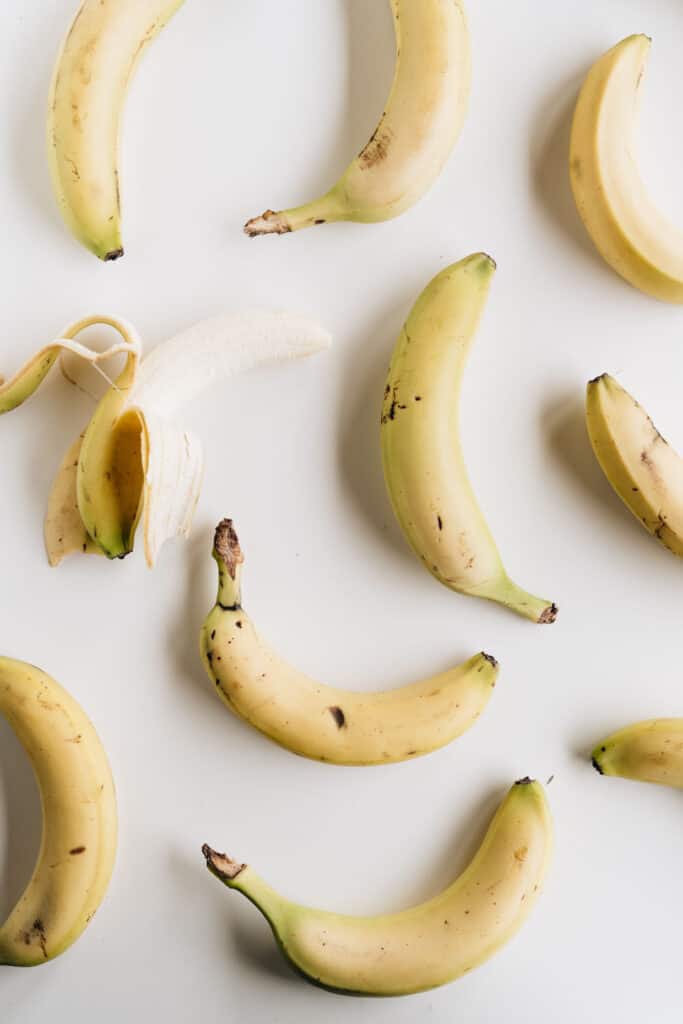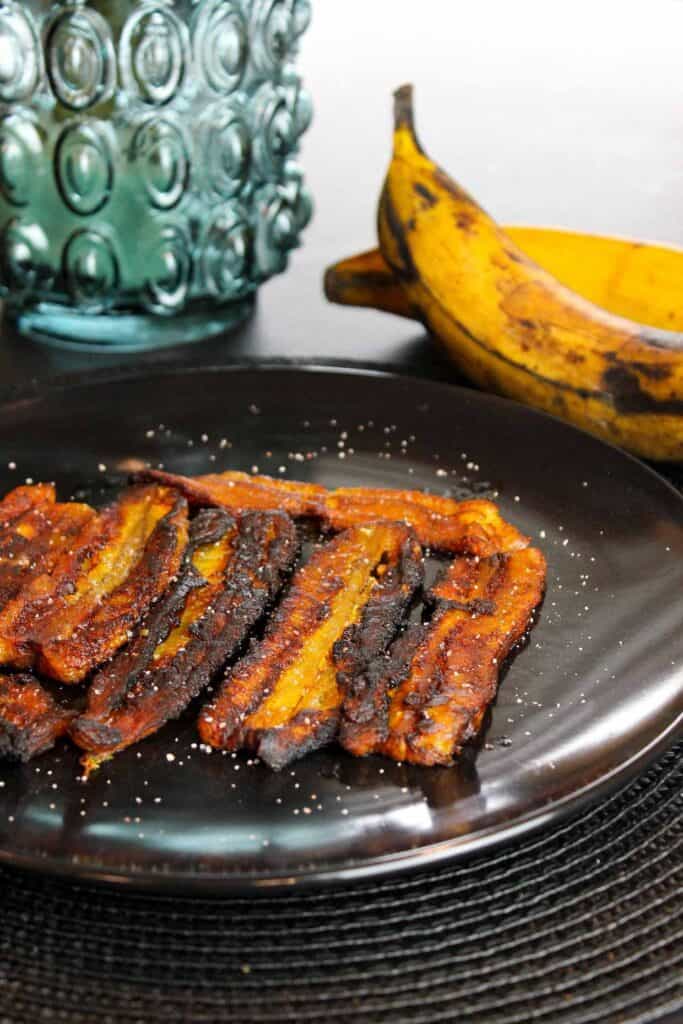Are you bananas for bananas or do you prefer plantains? While these two fruits look very similar, they have distinct differences in taste, texture, and culinary uses. This article will dive deep into exploring everything you need to know about the similarities and differences between these two delicious fruits. Get ready to peel back the layers in the fruity debate of plantains vs. bananas and discover what makes them stand apart.

How and where they’re grown
Both bananas and plantains grow in a formation called “hands” on a plant that is commonly thought of as a tree but is actually a giant herb. Banana and plantain plants are known as monocots, a group of plants that include grasses and palm trees. These plants feature a succulent stem instead of a woody trunk.
Bananas originated in Southeast Asia but are now grown in tropical regions all over the world including South and Central America, India, China, and Africa.
Plantains are also thought to have originated in Southeast Asia but are now grown more prominently in India, Africa, and Egypt as well as a smaller agricultural presence in the tropical Americas.
Both bananas and plantains require a humid tropical environment to grow and because of their herbaceous nature, cannot withstand temperatures below freezing.
FDL’S 75 Best Bites

Our cookbook with 75 tasty recipes will be your go-to kitchen companion for easy dinners with ad-free recipes right at your fingertips. Crafted by experienced chefs and recipe developers, this collection offers a treasure trove of tried-and-true dishes that make mealtime a breeze.
Get the Recipe: FDL’S 75 Best Bites
Taste and texture
The number one difference between plantains and bananas is that bananas can be eaten raw whereas plantains, no matter what stage of ripeness, cannot.
Bananas are sweet, soft and creamy and are used almost exclusively in desserts, breakfasts or snacks due to their sweet taste. The sweetness of a banana accelerates with the ripening of the fruit but even a green-tinged banana possesses an underlying sweet taste.
Plantains, which tend to be slightly larger than the average banana, are much more starchy in texture and mild flavored in taste. Green plantains are often cooked and served with savory dishes. Even though plantains take on a sweeter taste as they ripen, they still tend to be used almost exclusively in savory dishes whether cooked at the green or ripened stage.

How to know when they’re ripe
Bananas are considered ripe for eating when the peel has turned a solid yellow color from top to bottom without any greenish hue left. The fruit will continue to ripen if unpeeled and brown spots will start to dot the fruit. If left untouched for a longer duration, the entire fruit will become brown and very soft.
Both personal preference and application will determine at what point a banana should be used as even a green-tinged, unripe banana can be eaten and enjoyed. Typically, over-ripe browned bananas are preferred for baking. Their soft and mushy texture is more easily incorporated into batters and the sweeter flavor reduces the need for additional sugar in recipes.
Plantains follow the same outward appearance of ripening as bananas but are used more frequently in all stages of ripeness. A solid green and firm plantain is considered unripe but can still be cooked and enjoyed in savory dishes like tostones. Ripe plantains are dark yellow with many brown spots all over the peel. At this stage, the fruit is sweeter and mushier, much like the banana.
Nutritionally speaking
The commonality between plantains and bananas extends to their nutrition profile as well. Both fruits are good sources of nutrients and minerals such as potassium, magnesium, vitamin C, fiber and antioxidants.
When calculated per 100 grams of fruit, bananas average 23 grams of carbohydrates whereas plantains contain 32 grams. This will vary depending on the stage of ripeness.
Carbohydrates are the main macronutrient in both fruits with negligible amounts of fat and protein in either. In bananas, this comes mainly from sugar whereas, in plantains, the carbohydrates are more derived from starch.
Both fruits, especially when consumed in the less ripe stages, contain high amounts of resistant starch. This type of starch helps play a role in digestive health, blood sugar regulation and insulin sensitivity.
Culinary uses
How these two fruits are used in the kitchen may be the aspect they differ most in. Despite plantains sometimes being called cooking bananas, they have quite distinct applications in cooking.
Cooking with bananas
Due to their innate sweetness, bananas are used as snacks, in breakfasts and in a plentiful amount of baking recipes. They can even be made into alternative plant-based milk.
Beyond eating right out of the peel, try frozen, chocolate-dipped banana slices or spread some nut butter and dot with nuts, chocolate chips, or dried fruit to make an “ants on a log” type of banana snack.
For breakfast, frozen banana chunks are a great addition to smoothies for natural sweetness. They can also be swirled into oatmeal or incorporated into a breakfast bake.
Dessert is where the banana shines. From bread to muffins, pies, cakes, and bars, bananas can be used in almost any baking recipe. Satisfy a simple sweet craving by sauteing in some brown butter or caramelizing in the air fryer. Top air fryer bananas with a scoop of ice cream and enjoy a banana split vibe.
“My favorite preparation for bananas is caramelized bananas. They’re easy to make with a bit of sugar and butter on the stovetop. This highlights their natural sweetness and creates slightly crisp edges with a super soft interior.” — Gen La Rocca, Two Cloves Kitchen

Cooking with plantains
Compared to bananas, the culinary use of plantains is much more popular in Central America, South America and the Caribbean than it is in the United States.
The two most common dishes found in these cuisines are either mashed or fried plantains.
Mofongo, mashed green plantains, is a widely popular dish. Green plantains are either fried, boiled or roasted then mashed with salt, garlic and olive oil in a wooden mortar and pestle. Mofongo can be served with any desired protein for a more complete meal.
In Caribbean countries, frying plantains is more commonplace. The ripe fruit is sliced on the bias and either deep- or pan-fried in oil until crispy, then salted before serving.
“I never knew about plantains until I moved to Ecuador where they are a main staple in local cuisine. Here, green plantains are fried as patacones or boiled for soup, while yellow plantains are stuffed with cheese and then baked. My family never says no when I make a quick side dish by frying ripe plantains in lard and serving with a liberal dash of salt. It’s easy and super delicious.”
Jessica Haggard, Easy Homemade Life
Plantain chips are another way to enjoy this starchy fruit. They can be baked or fried until crispy and serve as a great alternative to tortilla chips when paired with salsa. They’re often used as a “scooper” for serving ceviche.
The final verdict on plantains vs. bananas
While it’s easy to confuse bananas and plantains upon a quick glance, it’s quite simple to differentiate the two after tasting.
With similar nutritional content and potential health benefits, the decision of which to use mostly comes down to a sweet or savory preference.
Plantains are starchy with a milder flavor than bananas allowing them to work well in savory dishes, while bananas work great in desserts or for enjoying on their own as a snack.
Gina Matsoukas is the photographer, writer, and recipe creator of Running to the Kitchen. Focusing on healthy, seasonal, whole-food recipes, her work has been featured in various online and print publications including Food Network, Prevention Magazine, and Women’s Health. Gina lives in central New York where she enjoys an active outdoor life.